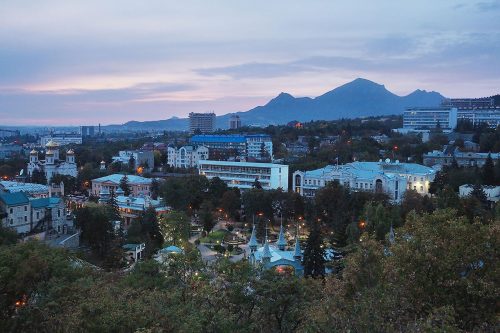Come to one resort, but get to four at once? Perhaps this is possible only in the Caucasian Mineral Waters. Caucasian Mineral Waters in 2021 is a mineral water for every taste, many colors, neat terrenkura paths, original old buildings, which once hosted Lermontov and Pushkin, new high-rise buildings of modern sanatoriums, and around there are mountains of unusual origin.

Spa wellness in the Caucasian Mineral Waters
The region is one of the leaders among Russian resorts with a share of up to 20% in the total Russian volume of spa services.
The health resort complex of the Caucasian Mineral Waters in the Stavropol Territory includes 124 health resorts in four resort cities: Kislovodsk, Yessentuki, Pyatigorsk and Zheleznovodsk. 91 of them are already welcoming vacationers from all over Russia, the rest are getting ready for the opening.
The region is one of the leaders among the country’s resorts with a share of up to 20% in the total Russian volume of spa services.
From mineral water to special rehabilitation programs
Each resort has its own characteristics and therapeutic profile in accordance with the type of springs (there are 14 of them in total). In Kislovodsk they heal for heart and lung diseases. Pyatigorsk specializes in problems of the musculoskeletal system. They go to Essentuki to treat the digestive organs, and to Zheleznovodsk kidneys. However, now each sanatorium has a wide range of medical services.
Continental, mild climate, a large number of sunny days, phytoncides of natural forests and forest parks, high ionization of air, picturesque nature all together give an additional healing effect.

Continental, mild climate, a large number of sunny days, phytoncides of natural forests and forest parks, high ionization of air, picturesque nature all together give an additional healing effect. Excursions to interesting places
Mass entertainment is not yet allowed, but vacationers have something to get carried away. Caucasian Mineral Waters is a real open-air museum. Mikhail Lermontov and Alexander Pushkin, Lev Tolstoy and Fyodor Chaliapin and other famous historical figures walked along these streets.
You can walk yourself, checking the information on the Internet, or you can with a professional guide. Since the beginning of July, a museum of local lore in Yessentuki. A house-museum of Lermontov in Pyatigorsk. A museum of Yaroshenko in Kislovodsk and others have been opened.

Smart technologies
Zheleznovodsk became the first in Russia to introduce the Smart City system, a joint project of the government of Stavropol and a company in the structure of Rosatom.
Interactive tourist kiosks on the streets of the city help to learn all about the sights, events and to find your way around the place.
The formation of an accessible and comfortable environment at the resorts is one of the priorities of the regional program “Tourist and Recreational Complex” and the government of Stavropol.

National dishes
Arriving at the resorts of the Caucasian Mineral Waters, be sure to try Ossetian pies and other Caucasian dishes.
In cafes and restaurants, whose summer verandas have already opened in every resort city, you can taste almost all Caucasian dishes. There are a couple of dozen recipes for one shish kebab it all depends on the nationality and habits of the cook. Do not forget to ask for tkemali sauce cherry plum with spices, garlic and pepper. And also Ossetian pies, Karachai khychins, Cossack shulum, all kinds of khachapuri. And wash it down with tea with mountain herbs.

Souvenirs for tourists
The most popular souvenir here is a pump-room mug with the name of the city in which you were resting. They come in many different types, take your time to buy, explore the variety first. Children are very fond of drinking from such mugs, and for adults it is always a cute gift. From Kislovodsk, you can bring a picture with views of the local nature at the entrance to the national park there is a permanent exhibition of artists who paint in different ways.
An original gift beech nuts, plane trees. Very tasty and unusual in taste.
Wooden souvenirs from tuesques, coasters and combs to paintings and exquisite souvenirs. Such a souvenir preserves the aroma and spirit of the nature of the Caucasian Mineral Waters.

History
In 1717, Peter I sent the German physician Gottlieb Schober to explore the North Caucasus. And in 1803, Alexander I issued a rescript “On the recognition of the state significance of the Caucasian Mineral Waters and the need for their arrangement”. And large-scale development of this region began.
On the site of the former military fortresses, cities were rebuilt: Pyatigorsk, Kislovodsk, Zheleznovodsk. The open springs of hot and cold waters were studied in detail, wooden and stone baths were built, hospitals were equipped, where soldiers and wounded were first sent.
Mineral water was drunk in special pavilions and galleries, which were erected near the springs. She was transported to villages nearby in earthen jugs or wooden barrels, but she quickly “fizzled out”. Under the Governor of the Caucasus Mikhail Vorontsov, mineral water was bottled in sealed glass bottles and exported outside the region.
In 1871, the first Draft of Essentuki Waters was opened. It was mined from 23 sources, which were described by the doctor of medicine Alexander Nelyubin in 1825. Especially valuable mineral composition was found in 4.17 and 20 wells. In 1911, a plant and a large warehouse for bottling the Essentuki mineral water were built there.
In 1894, industrial bottling of “Narzan” began in Kislovodsk. According to an old Caucasian legend, the water in the spring was called “Nart-sane” “drink of the narts”, or “hero-water”. In 1900, a factory building was built there, which produced more than a million bottles per year.











